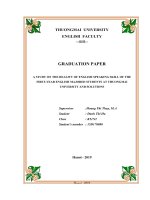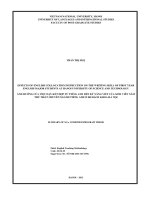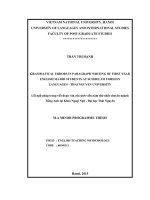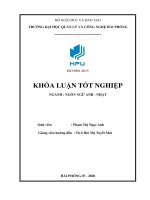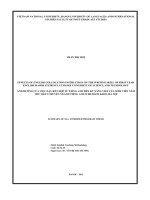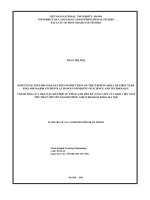Khóa luận tốt nghiệp vocabulary learing strategies of first year english majored students at vnua
Bạn đang xem bản rút gọn của tài liệu. Xem và tải ngay bản đầy đủ của tài liệu tại đây (941.67 KB, 43 trang )
VIET NAM NATIONAL UNIVERSITY OF AGRICULTURE
FACULTY OF EDUCATION AND FOREIGN LANGUAGES
BA THESIS
VOCABULARY LEARNING STRATEGIES OF FIRST
YEAR ENGLISH-MAJORED STUDENTS AT VNUA
NGHIÊN CỨU VỀ CÁC CHIẾN LƯỢC HỌC TỪ VỰNG
CỦA SINH VIÊN NĂM NHẤT NGÀNH NGÔN NGỮ ANH
Student: DO THI MINH TIEN
Student code: 621278
Major: ENGLISH
Supervisor: PHAM HUONG LAN, M.A.
Hanoi – 2021
VIET NAM NATIONAL UNIVERSITY OF AGRICULTURE
FACULTY OF EDUCATION AND FOREIGN LANGUAGES
BA THESIS
VOCABULARY LEARNING STRATEGIES OF FIRST
YEAR ENGLISH-MAJORED STUDENTS AT VNUA
NGHIÊN CỨU VỀ CÁC CHIẾN LƯỢC HỌC TỪ VỰNG
CỦA SINH VIÊN NĂM NHẤT NGÀNH NGÔN NGỮ ANH
Student: DO THI MINH TIEN
Student code: 621278
Major: ENGLISH
Supervisor: PHAM HUONG LAN, M.A.
Hanoi – 2021
CERTIFICATE OF ORIGINALITY
I, the undersigned, hereby certify my authority of the study project report
entitled “Vocabulary learning strategies of first year English-majored
students at VNUA” submitted in partial fulfillment of the requirements for the
degree of Bachelor in English Language. Except where the reference is
indicated, no other person‟s work has been used without due acknowledgement
in the text of the thesis.
Hanoi, 2021
Do Thi Minh Tien
Approved by
SUPERVISOR
i
TABLE OF CONTENTS
PART I: INTRODUCTION .................................................................................. 1
1.Rationale............................................................................................................. 1
2. Aims and objectives of the study ...................................................................... 2
2.1 Aims of the study ............................................................................................ 2
2.2 Objectives of the study .................................................................................... 2
3. Research questions ............................................................................................ 3
4. Scope of the study ………………………………………………………………………3
5. Significance of the study ………………………………………………………………3
6. Design of the study ……………………………………………………………………..3
PART 2: DEVELOPMENT ……………………………………………………………..5
Chapter 1: LITERATURE REVIEW………………………………………….…...…...5
1.1. Review of previous studies……………………………………….………….……...5
1.1.1. Review of the previous studies in the world…………………………….……..5
1.1.2. Review of the previous studies in Vietnam……………….……………….…...6
1.1.3. Summary……………………………………………………………….….…………8
1.2. Review of theoretical background……………………………………….………...8
1.2.1. Vocabulary……………………………………………………………….……….…8
1.2.2. Learning Strategies……………………………………………………….………...9
1.2.3. Vocabulary Learning Strategies………………………………………….………9
1.2.4. Types of vocabulary learning strategies……………………………..………...10
1.2.5. The importance of vocabulary learning strategy……………………..………12
Chapter 2: METHODOLOGY………………………………………………...………..14
2.1. Research governing orientation……………………………………………..…….14
2.2. Research methods………………………………………………………….....……..14
2.2.1. Research methodology…………………………………………………………...14
2.2.2. Research setting/ context……………………………………………………...... 15
2.2.3. Data collecting instruments ....................................................................... 15
ii
2.2.4. Data collecting procedures ........................................................................ 16
2.2.5. Data analysis ............................................................................................. 16
2.3. Summary ...................................................................................................... 17
Chapter 3: FINDINGS AND DISCUSSION
3.1. Finding 1: Vocabulary learning strategies frequently used by students. ..... 18
3.2. Finding 2: The most and the least frequently used strategies ...................... 19
3.2.1. Determination strategies............................................................................ 19
3.2.2. Social discovery strategies ........................................................................ 20
3.2.3. Social consolidation strategies .................................................................. 21
3.2.4. Memory strategies ..................................................................................... 22
3.2.5. Cognitive strategies ................................................................................... 23
3.2.6. Metacognitive strategies............................................................................ 24
3.3. Summary ...................................................................................................... 25
PART 3: CONCLUSION .................................................................................... 28
3.1. Recapitulation............................................................................................... 28
3.2. Conclusions .................................................................................................. 28
3.3. Limitations of the current research .............................................................. 29
3.4. Recommendations ........................................................................................ 30
3.4.1. Further study ............................................................................................. 30
3.4.2. Recommendations for learning and teaching English at VNUA………..30
REFERENCES
31
iii
ABSTRACT
The purpose of this study was to find out a strategy often use and the most
and least frequently used
vocabulary
learning
strategies used by 70 first
year English- majored students (K65) at Vietnam National University of
Agriculture (VNUA) in the second year semester of the academic 2020-2021.
The research method was survey research with descriptive statistics; the survey
questionnaire was adapted from Natpassorn Riankamol‟s 25- item Questionnaire
of Vocabulary Learning Strategies and was depended on Schmitt‟s Taxonomy.
The findings indicated that Memory strategies were at the first rank while social
discovery strategies were preferred the least. Through these findings, it showed
that students concentrated on how to memorize during the process of increase
the vocabulary to create motivation throughout their education. In memory
strategies, the most frequently used vocabulary strategy was “I write a new word
in a sentence so I can remember it”. And the least frequently used vocabulary
strategy was “I ask the teacher to translate the words into English.” in social
discovery strategies.
iv
List of tables and figures
Table 2.1
Items dividing into Schmitt‟s categories
Table 2.2
The information of respondents
Table 2.3
Usage averages of vocabulary learning strategies
Table 2.4
Use of determination strategies
Table 2.5
Use of Social discovery strategies
Table 2.6
Use of Social consolidation strategies
Table 2.7
Use of Memory strategies
Table 2.8
Use of Cognitive strategies
Table 2.9
Use of Metacognitive strategies
Table 2.10
The most frequently used vocabulary learning strategies
Table 2.11
The most frequently used vocabulary learning strategies
v
PART I: INTRODUCTION
1.Rationale
Nowadays, English is one of the dominant languages in the world. One of
the main factors to acquire a language is vocabulary. According to Harmer
(1997), if grammar is regarded as a factor to create a frame of language, the
vocabulary is a vital organ. One of the sources that the learner cannot
communicate fluently is because of their poor vocabulary, so the people who
have a large vocabulary after graduating from high school or university have
more advantage. There are many strategies that the learners apply to improve
their learning vocabulary and much research were carried out to investigate
those.
Researchers such as Laufer and Nation (1999), Maximo (2000), Read
(2000), Gu (2003), Marion (2008) and Nation (2011) and others have realised
that the acquisition of vocabulary is essential. Language learners should employ
a range of vocabulary strategies if they wish to make their vocabulary learning
effective.
Since the late 1970s, many researchers have paid much attention to
vocabulary learning strategies and considered these as a vital issue among
different strategies of language learning. Once foreign language learners have
effective vocabulary strategies, they will be more likely to become much more
successful language learners. Vocabulary learning strategies enable autonomy
and responsibility of students in their English learning (Oxford, 1994). (Gu, Y.
ve Johnson, R, 1996) (Oxford R. L., 1997)
When learning vocabulary, learners may apply more than one approach.
For example, some people like learning by heart, others often divide into many
topics (family, fruits, things in room, personalities, jobs, daily routine, etc.);
some others apply to speak a full sentence, or they may make a combination of
various strategies.
1
English is a relatively new major at Vietnam National University of
Agriculture. Students of this major not only learn about pronunciation,
semantics but also many other subjects at the same time as the four skills
(listening, speaking, reading and writing). All subjects require a number of
vocabularies, so I myself experienced the difficulty in learning vocabulary when
I was in my first year and I quickly forgot the vocabulary I had learned before.
This might be a common situation among lots of other freshmen at VNUA. In
addition, to be eligible to graduate, students have to achieve level C1 according
to the European reference framework. At level C1, students need to have 8000
vocabularies in their mind. It is obvious that learning vocabulary and applying
some strategies to acquire lexicon to learn better are very important to students.
Being aware that self-training about vocabulary strategies can give big
help to students in the process of learning vocabulary in specific and in the
process of learning English in general, I was greatly attracted by vocabulary
learning strategies and decided to choose this as the topic for my graduation
paper. Hopefully the results of my research will help to make some useful
suggestions in improving students‟ vocabulary learning.
2. Aims and objectives of the study
2.1 Aims of the study
This study aimed to look into some learning vocabulary strategies that
first year English-majored students adopted for building up their English
vocabulary during their study at Vietnam National University of Agriculture. It
found out the most and the least frequently used vocabulary learning strategies.
Thereby some suggestions would be made to help students with effective
vocabulary learning strategies.
2.2 Objectives of the study
This study had following objectives:
- Identifying the types of vocabulary learning strategies used by students
2
- Assessing how frequently vocabulary learning strategies are used
- Making some suggestions for students about an effective use of
vocabulary learning strategies.
3. Research questions
This study aimed to find out the answers to the following questions:
- Which strategies do students often use to learn vocabulary?
- What are the most and the least frequently used vocabulary learning
strategies by first year English- majored students at VNUA?
4. Scope of the study
This study investigated some vocabulary learning strategies that used by
70 first year English- majored students (K65) at VNUA. It was conducted
between January 20th and June 30th, 2021. Natpassorn Riankamol‟s 25-items
Questionnaire of Vocabulary Learning Strategies was employed to collect the
data.
5. Significance of the study
The results of the study reflected the use of vocabulary learning strategies
among students at VNUA. Based on this, some recommendations were made
about the use of vocabulary learning strategies so as for students to reach better
achievement in their learning. Suggestions may also be given in training
vocabulary strategies for students from teachers.
6. Design of the study
This study was divided into three parts: Introduction, Development and
Conclusion.
Part 1, Introduction, provides brief information about the rationale, the
aims & objectives, the research questions, the scope, the significance and the
design of the study.
Part 2, Literature review, presents an overview about some previous
studies and some theoretical background to the study.
3
Part 3, Methodology, includes the governing research orientation (the
major method & the research questions) and the detailed methodology of the
study (participants, data collecting instruments, data collecting procedures, data
analysis)
Part 4, Findings and Discussion, demonstrates the major findings of the
study as well as discussion around these findings.
Part 5, Conclusion, Limitations and Recommendations, claims the main
points of the study, some limitations of the study and recommendations for
further study as well as some suggestions to improve learning strategies among
English-majored students at VNUA.
4
Part 2: DEVELOPMENT
Chapter 1: LITERATURE REVIEW
1.1. Review of previous studies
1.1.1. Review of some previous studies in the world
Realizing the importance of lexical acquisition through learning
vocabulary strategies, foreign researchers have conducted many studies on this
issue.
A research from Oxford (1997) pointed out that learning vocabulary
strategies can be influenced by many factors like motivation, attitude, gender,
learning styles and etc.
In another research by Nagy and Scott (2000), he indicated that students
use contextual analysis to find out the meaning of a word by looking closely at
surrounding text. Because when students read, they can meet with an enormous
number of words as they read, some researchers believe that even a small
improvement in the ability to use context clues has the potential to produce
substantial, long-term vocabulary growth.
A study was done by Gu and Johnson (1996) with the investigation of
which strategies the learners at Chinese university used to learn vocabulary by
comparing the results with vocabulary size and language proficiency. The
authors concluded that students who are successful often choose the
metacognitive strategies.
In the study was done with some researchers: S Baskin, A Iscan, B
Karagoz, G Birol (2017) which applied Natpassorn Riankamol‟s 25- item
Questionnaire of Vocabulary Learning Strategies. Their research was operated
in Gaziosmanpasa University TOMER in the 2016- 2017 academic year with 22
students at level A1. The items were both in Turkish and English and it was
divided into 5 groups according to Schmitt (1997, 2000). The subject is novices
in learning English, so the result showed that determination strategies were
5
utilized the most and the type of strategy that students used the least was
cognitive strategies.
In Schmitt (2000), the absorption of a second language depends on the
lexical resource. Learning vocabulary is a sub-discipline of second language
acquisition, both of which have focused their attention on the needs of a large
number of learners to utilize their vocabulary knowledge. This can be done by
the help of vocabulary learning strategies.
In the study of Brown and Payne (1994), they found that all vocabulary
learning strategies are linked to the five steps: the first step is encountering new
words, the second step is getting an obvious image, the next is learning the
meaning of the words, the fourth is making a strong memory connection
between the forms and the meanings of the words, and the last step is using the
words frequently.
Natpassorn Riankamol's study (2008) was to investigate which English
learning vocabulary strategy students apply to find out most and the least at
Triam Udomsuksa School in the first semester of the academic 2008. In his
instrument, he used a 25-item questionnaire adapted from Schimitt's taxonomy,
so a 25-item questionnaire was divided into some groups to measure the
frequency of usage: determination strategies, social discovery strategies, social
consolidation strategies, memory strategies, cognitive strategies, metacognitive
strategies. In his research, he used frequency, percentages and means to analyze
the data. The mean score showed that the use of metacognitive strategies were
most frequently. The least frequently strategy was cognitive strategies.
1.1.2. Review of some previous studies in Vietnam
Currently, many scholars in Vietnam also have conducted numerous
studies about learning vocabulary strategies in a specific group of subjects. For
instance, in a research by Vi Van Huong (2018) called “Chiến lược và cách thức
tự học từ vựng tiếng anh hiệu quả cho sinh viên trường đại học Tây Bắc”. The
6
results of this study showed some effective strategies of students: firstly,
building motivation to self- study English vocabulary because it directly impacts
to the result, so the learners try to improve themselves by different ways;
secondly, recognizing important and popular vocabulary in self-study English
words by highlighting or noting this vocabulary that the native speakers often
use in communication daily. Thirdly, guessing the meaning- in the process of
reading or listening, the learners are difficult to fully understand but they can
guess the meaning based on the situation or content. Some other strategies were
found to be used such as using the dictionary, noting vocabulary, watching
movies and reviewing the vocabulary.
Pham Thi Thu Trang (2019) conducted a study namely “An investigation
into vocabulary learning strategies employed by the second-year non-English
major students at Thai Nguyen university of agriculture and forestry”. Her
study used some strategies (determination, social, memory, cognitive and
metacognitive) with 100 students in two English classes through the vocabulary
learning strategy questionnaire. The result indicated that determination strategies
were used the most which revealed that students favored guessing the meaning
of the word in textual context, using a bilingual or monolingual dictionary,
making word lists, using vocabulary cards while metacognitive strategies
(monitoring, decision- making,...)were preferred the least.
A scientific research was conducted by a student at the University of
Danang named Tran Huynh Thu Huong (2012) about “An investigation into the
vocabulary learning strategy of ESP students in college of foreign language”.
She pointed out that there were three issues in learning vocabulary of 100
research' subjects. These issues are: (1) using low-minded vocabulary learning
strategies (learning by heart, repeat a word many times, etc.); (2) students are
very lazy because they just look up the right meaning for the context that they
are using in the dictionary; (3) this is out of touch with reality. In her study, she
7
raised some profound solutions such as teachers should find out some benefits,
motivation, the learning styles, the self-awareness about the role of using
vocabulary strategies of students in each class.
Another study was done by a teacher, Pham Huong Lan (2016) at VNUA
namely “Nghiên cứu ảnh hưởng của việc sử dụng sổ ghi chép từ vựng đối với
việc học từ Tiếng Anh của sinh viên năm thứ nhất lớp tiên tiến, chất lượng cao
tại Học Viện Nông Nghiệp Việt Nam”. This strategy is quite user- friendly
because it not also helps you learn vocabulary according to each topic or take a
scientific note. The author divided into 2 groups, the first group used this
method and other one didn't apply. The result indicated that the group using the
vocabulary notebook showed better results than the other group on the test.
1.1.3. Summary
The above information can be seen that some previous studies in the
world have similarities with some studies in Vietnam. It has shown the
importance of vocabulary in learning a second language and researched as well
as gave some suggestions about vocabulary learning strategies for students.
I found that these above studies were done with an effective outcome at
universities. I wondered if they were suitable for my study environment at
VNUA, so my research confirmed the results that were made in previous
research. However, the research context in my study was the first year Englishmajored students (K65) at VNUA.
1.2. Review of theoretical background
1.2.1. Vocabulary
According to many scholars, words are considered the basic elements
allowing ideas to develop. There have been different definitions of words in
literature. Özbay & Melanlıoğlu (2008) ,cited in the study by S Baskin, A Iscan,
B Karagoz, G Birol (2017), defined the word as “the shape of the thoughts and
attitudes that we want to express”. Kantemir (1997) and Ediskun (1999) agreed
8
that the word involves a set of sounds carrying meaning when being
grammatically put into a sentence. According to Schmitt (2000:23), word
meaning consists of the connection of the word and its referent, and the letter
means the person, thing, action and situation. Word is a language unit serving as
a tool that one uses to express his certain thoughts, feelings (Swan & Walter,
1984).
1.2.2. Learning Strategies
According to the second language learning, strategy has been applied to
the conscious moves made by second language learners intended to be useful in
either learning or using the second language.
Oxford (1994) defines strategies as “actions, behaviors, steps, or
techniques students use, often unconsciously, to improve their progress in
apprehending, internalizing, and using the second language” (p.1).
Ellis (1985) considered learning strategies as how learners lay up new
second language rules. This process can be pre conscious or subconscious. He
said that it is the mental processes of acquiring and using a second language.
O‟Malley and Chamot (1990, p.1) defined learning strategies as “the special
thoughts or behaviors that individuals use to help them comprehend, learn or
retain new information”.
1.2.3. Vocabulary Learning Strategies
The first development in language learning strategies area began in the
1970s with research to recognize the characteristics of good language learners
(Naiman et al., 1978; Rubin, 1975).
Vocabulary learning strategy, according to Oxford (1994), are special
activities that learners perform to make learning vocabulary the easiest, fastest,
more fun, active and easy to apply them in communication and use of language.
9
Schmitt says learning is “the process by which information is obtained,
stored, retrieved and used… Therefore, vocabulary learning strategies could be
any which affect this broadly defined process” (1997, p.203).
Nation (2001) considers vocabulary learning as a deliberate process which
possesses intentional character. He established his description on the properties
and qualities of a strategy which fulfills teacher‟s aims.
1.2.4. Types of vocabulary learning strategies
As it is made clearly by many different researchers, there are a wide range
of different vocabulary learning strategies.
According to Stern ( 1992: 262-266), there are 5 main groups of
strategies:
- Management and Planning Strategies.
- Cognitive Strategies
- Communicative- Experimental Strategies
- International Strategies
- Affective Strategies
Stoffer (1995, cited by Kudo, 1999: 6) devises a Vocabulary Learning
Strategy Inventory consisting of 53 strategies. Through factor analysis it is
found that the strategies are clustered into nine categories: strategies involving
authentic language use, strategies used for self-motivation, strategies used to
organize words, strategies used to create mental linkages, memory strategies,
strategies involving creative activities, strategies involving physical action,
strategies used to overcome anxiety and auditory strategies.
According to Schmitt (1997) & Schmitt (2000), there are five strategies
(determination, social, memory, cognitive, and metacognitive) as followed:
- Determination strategies (DET) help learners to determine the meaning
by using dictionaries, guessing the meaning from the context and identifying the
parts of speech and constituent elements. In other words, determination
10
strategies are individual learning strategies that help learners to identify the
meaning of new words without the other‟s help.
- Social strategies (SOC) can be used to determine the word definitions by
asking teachers, classmates and native speakers.
- Memory strategies ( MEM) are a large number of strategies that learners
apply to recall vocabulary. In other words, Memory strategies help learners to
acquire the new words via mental processing by connecting their background
knowledge to the new words.
- Cognitive strategies ( COG) deal with mechanical aspects of learning
vocabulary and are not related to mental processing such as taking notes and
highlighting new words, making lists of new words, using flashcards to record
new words, putting English labels on physical objects, keeping a vocabulary
notebooks, and writing the words many times.
- Metacognitive Strategies (MET) include monitoring, decision-making,
and assessment of one‟s advance. They can also aid learners to specify suitable
vocabulary learning strategies for learning new words.
Schmitt‟s taxonomy (1997) was a comprehensive inventory of vocabulary
learning strategies. He divided the strategies into two groups: the ones to
determine the meaning of new words when learners encounter them the first
time, and the ones to consolidate meaning when learners encounter words again.
The former group contains determination and social strategies and the latter
contains cognitive, metacognitive, memory and social strategies. Schmitt
includes social strategies in both categories since they can be used for both
purposes.
In Nation‟s study in 2001, he presented a general classification of three
types of vocabulary learning strategies. The first one is planning vocabulary
learning - the learners should set up the goals and a clearly strategy to study
vocabulary. The second vocabulary learning strategy is sources. In order to solve
11
problems with new vocabulary , learners have to be able to get information
about the words (knowing the stems and affixes or the meaning of words by
checking guesses from context, strengthening form, consulting reference sources
properly). The third vocabulary learning strategy is processes, which involves
ways of remembering vocabulary and making it available for use.
In my study, I chose Schmitt‟s Taxonomy (1997) as my theoretical
framework.
1.2.5. The importance of vocabulary learning strategies
Vocabulary learning strategies are of great importance in language
learning. They are the key to the successful vocabulary acquisition which
ultimately highly contributes to the success of a language learner.
In a view of Nation (2001), learners can achieve a number of vocabulary
thank to the help of vocabulary learning strategies and that these strategies are
truly useful for students of different language levels.
According to Gani Hamzah et al (2009), the students have different kinds
of vocabulary learning strategies. They can be confident and learn more
vocabulary by using them in suitable situations, it also might considerably make
the learning process of new vocabulary simpler for students, for example, when
the student selects which words to study himself/ herself they can remember the
words better than when the words are chosen by someone else (Ranalli, 2003, p.
9).
Chamot at al. (1999) also stated that “differences between more effective
learners and less effective learners were found in the number and range of
strategies used, in how the strategies were applied to the task and whether they
were appropriate for the task” (p. 166).
Wilkins- a famous linguist- considered that “without grammar, little can
be expressed; without vocabulary, nothing can be expressed” (1978, p.111). He
comments, “no matter how good one‟s grammar is and how beautiful one‟s
12
pronunciation is, but if one has not enough vocabulary to convey one‟s own
feelings or to understand others‟ opinions, one still cannot communicate with
others in the language”.
13
Chapter 2: METHODOLOGY
2.1. Research governing principles
2.1.1. Research questions
This study aimed to find out the answers to the following questions:
- Which strategies do students often use to learn vocabulary?
- What are the most and the least frequently used vocabulary learning
strategies by first year English-majored students at VNUA?
2.1.2. Major methods
The main methodology of this study is the survey research with the use of
questionnaires aiming to investigate students‟ use. The results were analyzed
using SPSS program version 22.0.
2.2. Research methods
2.2.1. Research methodology
This study was a survey research about vocabulary learning strategies of
first year English- majored students at VNUA. According to Pinsonneault and
Kraemer (1993), they gave a definition of survey as a “means for gathering
information about the characteristics, actions, or opinions of a large group of
people” (p. 77).
A research of Kraemer (1991) indicated some characteristics of survey
research. He said that survey research was employed to describe quantitatively
aspects of a certain population by examining the relationships with variables. In
addition, because the data was collected from people, so it was entirely
subjective. Finally, survey used the group of people that was chosen before to
give some findings which represented to the population.
Therefore, I had chosen survey research as a method in my research. The
survey results were analyzed through using SPSS program version 22.0
according to calculating descriptive statistics.
14
2.2.2. Research setting/context
The questionnaire was distributed to 70 first year English- majored
students (K65) at VNUA. These students had entered the second semester of the
first year, so they were studying some subjects to achieve level B1 like: writing
2, reading 2, etc. Due to a new studying and teaching environment as well as
most of the time being self-educated, there were some students who were not
familiar with this. On the other hand, they have different learning capacities
significantly.
2.2.3. Data collecting instruments
In this study was done by providing a questionnaire adapted from
Natpassorn Riankamol‟s 25-item Questionnaire of Vocabulary Learning
Strategies. The base of this questionnaire laid in Schmitt‟s taxonomy of
vocabulary learning strategies. There were 25 questions in the questionnaire.
This was shown by table 2.1:
Table 2.1. 25- Items dividing into Schmitt’s categories
Items
Schimitt‟s classification
1,2,3
Determination strategies
4,5,6,7
Social discovery strategies.
8,9,10
Social consolidation strategies.
11,12,13,14
Memory strategies
15, 16, 17, 18, 19, 20
Cognitive strategies
21, 22, 23, 24, 25
Metacognitive strategies.
The questionnaire by Natpassorn Riankamol has been widely used in
different research projects to serve the purpose of investigating learning
strategies among students. That was the reason why I chose this questionnaire as
the data collecting instrument in my study. In this study, the questionnaire
15
consisted of 2 parts. In part 1, it was about the information of the participants
(gender, month of learning English, class, etc.). Whereas, part 2 included 25
items. The respondents were asked to rate each strategy on a five- point Likert
scale indicate the frequency of usage of the strategie was as follows:
0= never
1= seldom
2= sometimes
3= often
4= always
2.2.4. Data collecting procedures
The present study employed the method of survey research. There were 3
steps in processing of collecting data:
+ Step 1: Pretesting and collecting a survey questionnaire.
There were 5 pilot survey questionnaires distributed to 5 freshmen
students through Google Form who were joining the English Club at VNUA to
make sure that they understood the questions or not.
+ Step 2: Editing the questionnaire again.
+ Step 3: Testing and collecting a survey questionnaire officially.
2.2.5. Data analysis
The survey results were analyzed by quantitative methods through using
SPSS program version 22.0. Data about their personal opinions of learning
strategies had calculated and presented in percentage terms. To evaluate the
level of each variable, the following mean score range between 1.00 and 5.00
was used to measure level of vocabulary learning strategies as well as level of
agreement or disagreement in the questionnaire. Interpretation of mean score at
each level of the variables was interpreted using a table that was modified from
Nunally and Bernstein (1994). It is shown in the table below:
16
Mean Range
Interpretation
3.68 – 5.00
High
2.34 – 3.67
Moderate
1.00 – 2.33
Low
2.3. Summary
To sum up, this chapter had devided into 2 main sections that included:
Research governing principles and Research methods. The present study applied
the method of survey research, a questionnaire that adopted Natpassorn
Riankamol‟s 25-item Questionnaire of Vocabulary Learning Strategies. It was
used to get student's opinion about learning vocabulary strategies.
17
Chapter 3: FINDINGS AND DISCUSSION
This chapter reports the findings obtained from questionnaires. The results
were divided into two parts: which strategies do students often use, and what the
most and least frequently used strategies were applied. Tables are used to show
mean scores, Std. Deviation, rating of strategic level and of each vocabulary
learning strategy inventory for illustration.
3.1. Finding 1: Vocabulary learning strategies frequently used by students.
Table 2.3.Usage averages of vocabulary learning strategies
Determination
strategies
Social
Social
discovery consolidation
strategies
strategies
Memory
Cognitive Metacogn
strategies
strategies
itive
strategies
Mean
2.62
2.38
2.50
2.67
2.44
2.57
Rank
2
6
4
1
5
3
Order
According to the average in table 2.3, students used frequently the
memory strategies most (M= 2.67). It means that students often exert these
strategies to recall the lexical through mental processing. Memory strategies
connect between the learners‟ previous knowledge and the vocabulary via the
indirect definition like using pictures, using words in the sentences, using affixes
and roots, etc. This result was similar to Kafipour's findings in 2010, in which
memory strategies were shown to be the most commonly used tactics by Iranian
EFL undergraduate students. The explanation for this was that post graduation
were more successful learners who used a variety of vocabulary acquisition
tactics instead of just learning by heart and rote learning. Determination
strategies were found as the second most frequently used strategy (M= 2.62).
Because the object was students at level A1, so they became independent with
their learning, so they employed more determination tactics such as guessing the
18
